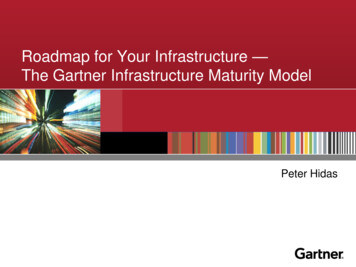
Transcription
Roadmap for Your Infrastructure —The Gartner Infrastructure Maturity ModelPeter Hidas
Infrastructure – Under Sea LevelUseRun
Why Is Infrastructure Important to Business?
IT Infrastructure and Operations OverviewIT Infrastructure: Thesystem of hardware, softwareand service componentsthat supports the delivery of businessapplications and IT-enabled processesIT Operations: The management andbusiness processes associated with ITinfrastructureIT Infrastructure and OperationsLeaders are executives, managers andsenior IT professionals who plan,manage and run I&OIn most enterprises, I&O typicallyis 70% of the: CIO's top issues Total IT budget and 50% of theIT professionalsI&O leaders' mission is to deliverIT services to the BuildPlan/BuildDeliver IT Services
IT Infrastructure Maturity Model Gartner s Infrastructure Maturity Model identifies6 development stages – how far has yourinfrastructure got? The model helps you to self-evaluate and builda strategic plan to reduce infrastructure costs,increase agility, improve service-levelmanagement and staffing development Modify it according your own goals!
The End Station:Real-Time InfrastructureA real-time infrastructure is: An IT infrastructure shared across customers, business units and applicationsDynamically driven by business policies and service-level requirementsAutomatically configured and optimized (―tera-architecture‖)Efficient use ofresources toservice policiesOptimizationIT service definitions Service agreements Business priorities Self-discover, installand oliciesProvisioningWorkloads/DataServices That meetbusinessrequirementsAvoid, predict andreact to failures
Server Virtualization: Where Is It Taking Us?Before Virtualization After tyPlanningHighAvailability Server SprawlLow UtilizationSynchronous DeploymentCapacity Planning by ServerResource Management by ServerDisaster Recovery by DuplicationManagement and AutomationDisasterRecoveryWithoutDuplication
The Infrastructure Maturity StandardizedBasicReactReducecomplexityEconomiesof yMonths toweeksWeeksWeeks todaysWeeks tominutesMinutesMinutes tosecondsEconomics icSLAsClass-ofserviceSLAsFlexibleSLAsEnd-toend SLAsBusinessSLAsAgilityQuality ofServiceNo SLAs
Infrastructure Maturity ThroughPeople, Process and TechnologyPeople Standardized RationalizedVirtualized Organization structureand ownershiprationalized across ITOrganization alignedto pooled asset usage IT organizationaligned to servicedelivery IT proactivelyinfluences use oftechnology to drivebusinessService-BasedReal-TimeIT owns assetsProcesses, tools aresharedProcessTechnologyInfrastructure lifecycle standardsBasic SLAsEvent management Mature and integratedsystems managementprocesses Holistic capacitymanagementFlexible chargeback Servers, storage,network capacity isvirtualized Measure, report,guarantee end-to-endservices Service managementtools manage end-toend End-to-end servicesare centrally managedand balanced The business hasdirect interface toservice prioritization StandardconfigurationsTools to monitorassetsIntegrated systemsmanagement toolsConsolidated assets
The Infrastructure Maturity Modelin more idateto ecomplexityEconomiesof scaleFlexibility,reduce e-leveldeliveryObjectiveReactAbility toChangeMonths toweeksWeeksWeeks todaysWeeks tominutesMinutesNone, ad hocFixed costsReduced,fixed costsFixed sharedcostsVariableusage costsBusinessInterfaceNo SLAsClass-ofservice SLAsClass-ofservice SLAsFlexible red poolsEnd-to-endSLAsServicebased poolsNoneCentral control emanagementPricingSchemeOrganizationIT Chaotic —Management ReactiveProcesses Ad hocReactive —ProactiveLife icy/ValueBasedDynamicoptimization tomeet SLAsBusinessagilityMinutesto edsharingBusinessorientedValuePolicymanagement
Infrastructure Maturity Evaluation:Where Users Are (December, ce-BasedReal-Time010203040PercentageSURVEY (December, 2005):Where would you place your organization on the infrastructurematurity model? (n 727)5060
IT Management Process Maturity ModelLevel 3ServiceLevel 4ValueIT as strategicbusiness partnerLevel 2 IT and business IT as a servicemetric linkageProactiveprovider IT/business Analyze trends Define services,Level 1collaboration Set thresholdsclasses, pricingReactiveimproves business Predict problems Understand costsLevel 0 Fight firesprocess Guarantee SLAs Measure appli InventoryChaoticcation availability Measure and report Real-time Desktop SWinfrastructure Ad hocservice availability Automatedistribution Business planning Undocumented Mature problem, Integrate processes Initiate Capacity Unpredictableproblem mgmt. configuration,Manage IT as a Businessmgmt.change,assetprocess Multiple helpand performance Alert anddesksService and Account Managementmgmt. processesevent mgmt. Minimal IT Measure componentService Delivery Process Engineeringoperationsavailability (up/down) User callOperational Process EngineeringnotificationTool Leverage
Infrastructure and Operations dVirtualizedServicePolicy/Based Value-BasedProactiveReactiveChaoticIT operationsandmanagementprocessesRTI
Recommendations Build an overall infrastructure vision––RTI is our vision — what's yours?What would have the greatest positive impact on your business?Near-term and long-term? Evaluate your infrastructure against the vision–Use our constructs to drive the discussion and make changes as needed Build a periodic process to re-evaluate your infrastructure, toevaluate technologies and to adjust your strategic plan––Measure your progress: the closer to the business, the better(costs, quality/service levels, agility)Always consider alternative sourcing, but make strategic choices Determine short-term (12 to 18 month) goals and execute them–Through IMM's "virtualization" stage, all efforts should be self-funding,with rapid ROI, all while increasing quality and agility Consider vendors with respect to how they’re helping you tostrategically evolve your infrastructure
Supporting Slides
Infrastructure Maturity Model:2. Becoming StandardizedPrior Situation: Assets are ―owned‖ by business units; there’s no consistency in ITprocesses or technologies; no idea of costs; complexity — too much varietyOwnership IT owns all infrastructure assets. Assets are inventoried and tracked. Asset usage by business unit is roughly understood. Asset monitoring is standard across infrastructure(tools, processes).Inhibitors: Political control of assetsStandards No asset is acquired without standards approval. All asset procurement is centralized. IT has created standard server configurations. There’s an asset change management process. There are no deployed, unused assets. IT offers class-of-service/tiered SLAs. IT management processes are shared throughout IT.Inhibitors: Very specific application requirements,unique service-level requirementsReturn on InvestmentEconomic: Reduction inwasted assets, costreductions throughconsolidated negotiations,labor savings throughreduction in complexity(configurations, organization,processes)Quality: Class-of-serviceSLAs with fixed costing,faster problem resolutionAgility: Acquisitions anddeployments are faster
Infrastructure Maturity Model:3. Becoming RationalizedPrior Situation: No economies of scale — many assets are doing the samething in many locations; there’s little automationLocation Physical sites have been reduced to an appropriatenumber.Inhibitors: Costs of physically relocating (assets,skills), telecom, regional regulations and lawsWorkloads and Assets Storage has been consolidated. Servers have been consolidated. Operating system instances have been reduced to arequired minimum. IT has a mature availability management process. IT has appropriate disaster recovery in place. Chargeback is optionally offered on a percentage ofasset basis.Inhibitors: Software support/licensing, technologies toenable consolidation, costs associated with replacinghardware, and political and organizational issuesrevolving around asset ownership and managementReturn on InvestmentEconomic: Fewer physical sitesreduces fixed costs; consolidatedworkloads and assets reducecapital expenses and somewhatreduce labor costs; elimination ofcost redundancy.Quality: Fewer locations meansfaster reaction to problems;fewer assets enables moremature availability management;chargeback can be based onpercentage of assets used;disaster recovery expandedappropriately.Agility: Assets can bereallocated as needed withoutphysically moving them.
Infrastructure Maturity Model:4. Becoming VirtualizedPrior Situation: Assets operate on physical boundaries — no flexibility;capacity is managed one asset at a timeInternal Storage has been virtualized and server compute powercan be allocated in granular percentages. Server compute requirements by application can be scaleddynamically. Applications can be moved between servers. Storage and server capacity is managed holistically, andexcess is pooled. Capacity planning is mature and centralized.Inhibitors: Need for software pricing to become moreusage-based; the need for software licensing to becomeless tied to specific hardware; political and ownershipissues of assets; and the immaturity of technologies toenable virtualizationExternal IT offers a dynamic resource utilization chargebackmechanism for server, storage and network use. SLAs are flexible and can be changed (cost and serviceprovided) within a day or so.Inhibitors: BusinessReturn on InvestmentEconomic: Hardwarecapacity reduced topragmatic minimum; virtualdeployment time reduceslabor cost.Quality: Chargeback can bebased on actual usage;workloads can be reallocatedeasily to avoid downtime.Agility: SLAs can be flexible;resource usage can bechanged quickly.
Infrastructure Maturity Model:5. Becoming Service-BasedPrior Situation: Assets are efficient, but they’re managed as assets, not aselements of an end-to-end serviceInternal Services are managed holistically. Asset failures have minimal impact on services. Service life cycle (deployment, maintenance, retirement) isautomated. Service-level pricing beats outsourcing alternative —services that can’t are outsourced. Flexibility of SLAs beats outsourcing alternative.Inhibitors: Service-based active management tools areimmature; applications aren’t operationally aware andmanageable; staff needs to become service-centric.External SLAs are flexible and can be changed (cost and serviceprovided) within minutes. Chargeback is variable based on customer-defined SLAs. The business and IT completely agree on the SLA andassociated costs. Business and IT costs are aligned.Inhibitors: Changes in the relationship/costing with thebusinessReturn on InvestmentEconomic: Labor focusesmore on service management,less on resources; automationtools manage life cycles.Quality: Chargeback is basedon specific holistic services,not resources; business and ITare aligned on costing and canrelate to business value.Agility: SLAs can be managedflexibly as holistic services,increasing or decreasingresources as services require.
Infrastructure Maturity Model:6. Becoming Policy/Value-BasedPrior Situation: Services are managed holistically, but manuallyInternal Asset usage is balanced among services based onpriorities, value and policies.External Chargeback is dynamic, based on customerdefined policies and SLAs. Business and IT strategies are aligned. IT influences business strategy.Inhibitors: Becoming policy/value-based requiresbusiness buy-in, changes in business processes todynamically leverage infrastructure agility, andlinkages between business and IT.Return on InvestmentEconomic: Labor focusesmore on service management,less on resources; automationtools manage life cycles.Quality: Chargeback is basedon specific holistic services,not resources; business and ITare aligned on costing and canrelate to business value.Agility: SLAs can be managedflexibly as holistic services,increasing or decreasingresources as services require.
The Infrastructure Maturity Model Agility Economics Quality of Service Basic Rationalized Virtualized Service-Based Standardized Reduce complexity Economies of scale Flexibility Service-level delivery React Weeks Weeks to days Weeks to minutes Minutes Months to weeks Cost center Static usage Flexible usage costing Variable usage costing Subsidized











